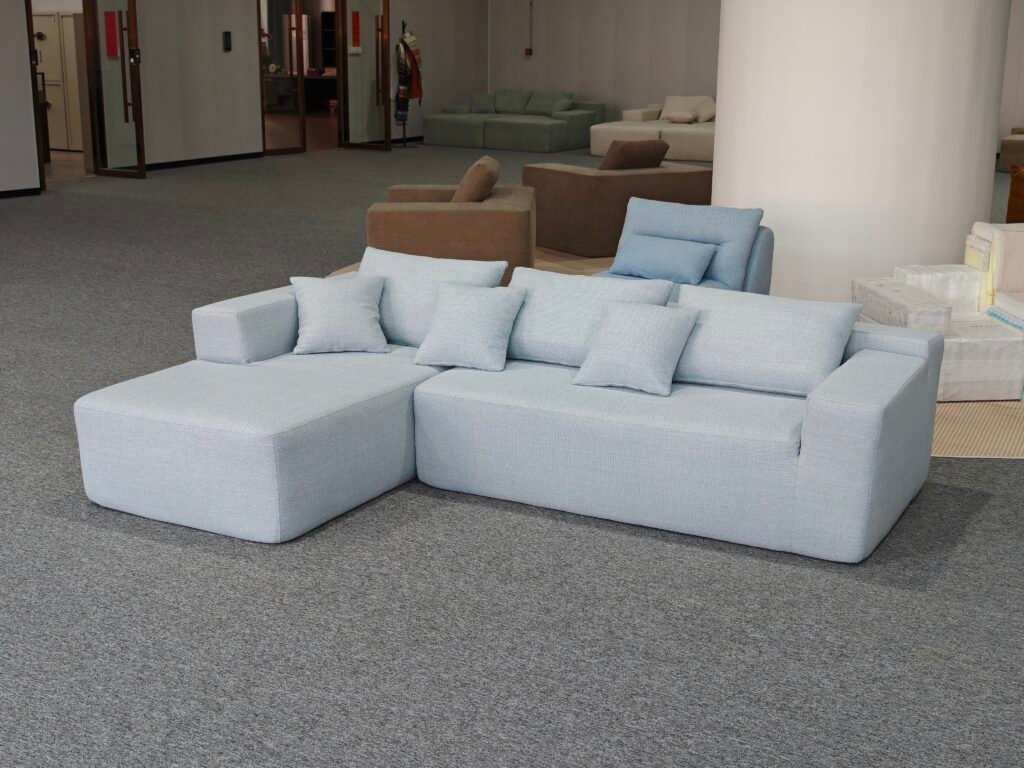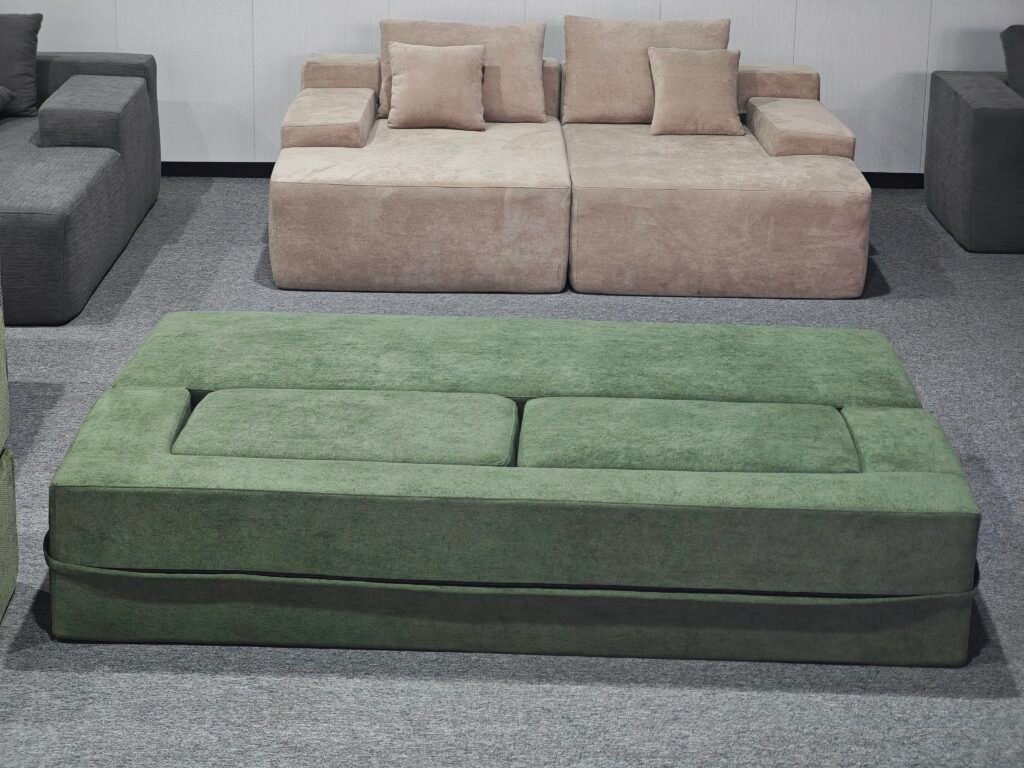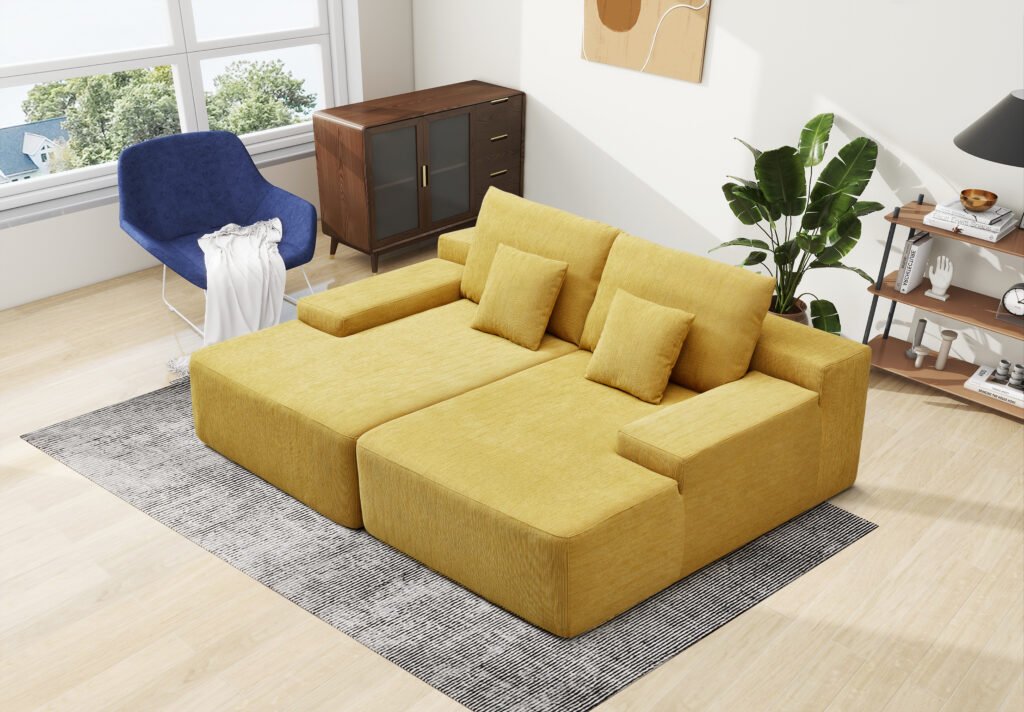In today’s fast-evolving furniture industry, the packaging and manufacturing of sofas have witnessed remarkable innovations, particularly with the emergence of the compressed sofa factory model. Modular Sofas (modular-sofas.com) stands at the forefront of this movement, specializing in modular, space-friendly sofas that fit modern lifestyle demands. A crucial decision for manufacturers and brands operating in this niche is the choice between fabric compress sofas and leather compress sofas—both of which have distinct characteristics impacting production, packaging, user experience, cost, and sustainability.
This article offers a deep dive into the comparative aspects of fabric and leather compress sofas, empowering manufacturers, retailers, and consumers to make informed decisions aligned with performance and market trends.


Material Characteristics and Compressibility
Fabric compress sofas utilize woven, knitted, or engineered textile surfaces ranging from polyester blends to microfiber, Velvet, or performance fabrics specially treated for stain resistance and durability. Fabric, by its nature, is lightweight, soft, and highly flexible, which offers significant advantages in vacuum compression packaging.
The compressibility of fabric sofas is typically higher because the textiles can fold, crease, and conform closely under pressure without damage. This means that factory vacuum compression machines, central to a compressed sofa factory’s workflow, can efficiently reduce volume and package multiple units for shipment, reducing freight costs and warehousing space dramatically.
By contrast, leather compress sofas require premium-grade, supple leather to undergo compression without cracking or losing finish quality. Leather's rigidity and natural texture limit the degree of compression possible without risking damage. To maintain the integrity of a compressed leather sofa, manufacturers must employ advanced foams and carefully controlled conditioning during compression and packing stages. Though leather compress sofas occupy more volume in packaging and must be handled delicately, the material’s durability and aesthetics attract a premium market segment.
Comfort, Aesthetic & Consumer Appeal
Fabric sofas offer immediate softness, warmth, and breathability. Consumers often perceive fabric compress sofas as cozy and inviting upon delivery. The diverse textures and wide color palettes available in fabric upholstery allow brands to cater to varied consumer tastes and adapt quickly to regional style preferences. Furthermore, performance fabrics treated for stain resistance or antimicrobial properties enhance usability, particularly in homes with children or pets.
Leather sofas deliver a markedly different feel—sleek, firm at first, and developing a natural patina that enhances their luxury appeal over time. This elegance commands attention in high-end living spaces and is often associated with prestige and longevity. However, leather’s reduced breathability can make sitting less comfortable in hot or highly humid environments, requiring consumers to adopt seasonal comfort strategies.
Consumer preferences can often be polarized. Younger buyers or those renting often gravitate toward affordable, customizable fabric compress sofas, while established homeowners or premium furniture buyers value leather options for their traditional, opulent feel.
Manufacturing and Production Considerations
From a compressed sofa factory perspective, fabric compress sofas generally present fewer production challenges. The fabric’s pliability simplifies module design for compression, reduces labor intensity during upholstery, and allows for greater scalability in assembly lines. Moreover, the wide availability of multiple fabric supply chains ensures competitive procurement costs and variety.
Leather compress sofa manufacturing involves careful leather selection, skilled craftsmanship, and more meticulous quality control. The compression packaging requires specialized conditioning to ensure leather elasticity under vacuum compression without developing unsightly creases or cracks. Notably, the costs of sourcing top-grade leather and the complexity of packaging contribute to higher capital and operational expenses compared to fabric options.


Packaging, Shipping & Logistics Efficiency
Packaging plays a pivotal role in the success of compressed sofa products, especially for exporters and brands striving for cost-efficiency.
| Feature | Fabric Compress Sofas | Leather Compress Sofas |
|---|---|---|
| Weight | Lighter; facilitates compact, dense packing | Heavier; packs are bulkier to avoid damage |
| Compression Ratio | High; fabrics fold and compress easily | Moderate; limited by leather flexibility |
| Packaging Size | Smallest, maximizing container utilization | Larger; requires protective padding |
| Transport Costs | Lower due to volume and weight savings | Higher freight expenses due to size & weight |
| Handling & Storage | Easier handling, stackable & space-efficient | More fragile; careful handling needed |
| Packaging Materials | Mostly synthetic fabric wraps, recyclable | Special moisture-resistant, cushioning wraps |
| Risk of Transit Damage | Low; fabric is resilient | Higher; leather prone to scuffing or cracking |
| Scalability for Export | High; supports large volume shipments | Lower; more selectively packaged |
This table highlights how fabric compress sofas provide logistical flexibility that lowers costs along the supply chain, essential for factories specializing in high-volume production and international export.
Cost Dynamics and Market Pricing
The cost structure surrounding fabric and leather compress sofas significantly influences brand positioning and profitability.
Fabric compress sofas typically allow smaller upfront investments in upholstery materials and reduced labor costs, enabling compressed sofa factories and brands to offer competitive pricing attractive to budget-conscious or first-time buyers. Mass production capability and efficient packaging further drive down costs.
Leather compress sofas command a higher price point justified by the premium aesthetic and longer lifespan. Higher material costs, specialized production techniques, and packaging requirements elevate the retail price, confining their appeal to customers prioritizing status and durability.
Offering fabric compress sofas can accelerate market penetration for entry and mid-tier brands, while leather compress sofas fit well in upscale market niches focused on exclusivity and luxury.
Maintenance, Longevity & Sustainable Impact
Fabric sofas may experience pilling, fading, or staining over time. While some modern fabrics have robust stain repellency and fade resistance, regular cleaning and gentle care are essential. Fabric sofas generally have a shorter lifespan compared to leather, averaging around 5-7 years depending on usage.
In contrast, leather sofas, with careful maintenance, can last 10-15 years or more. The natural resilience of leather combined with its ability to age beautifully increases their value over time but requires periodic conditioning and protection from scratches and extreme temperatures.
From an environmental standpoint, fabric compress sofas have an advantage if made with recycled or sustainably sourced fibers. The compress packaging reduces freight emissions substantially. Leather production involves intensive labor and chemical processing (tanning), which raises concerns over environmental impact and livestock agriculture’s carbon footprint.
The industry increasingly sees experimental blends and eco-leathers to bridge premium finishes with sustainability goals.


Consumer Demographics and Lifestyle Fit
Fabric compress sofas attract younger demographics, renters, families with children or pets, and consumers seeking affordable yet stylish furnishings. Their extensive color and texture palette facilitates personalization, moving with trends in fast furniture and online retail growth.
Leather compress sofas appeal to buyers valuing longevity, classical styling, and those furnishing formal living spaces or executive offices. They complement consumers who are less price-sensitive and more focused on prestige and perceived value.
Summary Table Comparison
| Aspect | Fabric Compress Sofas | Leather Compress Sofas |
|---|---|---|
| Weight | Lightweight, supports efficient packaging | Heavier, requires careful handling |
| Compressibility | High – fabrics compress easily & recover shape | Moderate – requires supple leather |
| Cost | Lower initial cost, affordable for mass market | Higher cost, premium segment |
| Comfort | Soft, breathable, immediate cozy feeling | Firmer initially, softens; luxurious feel |
| Durability | Moderate lifespan; susceptible to wear & staining | Long lifespan; ages gracefully |
| Maintenance | Requires vacuuming and stain treatment | Wipe clean, condition leather periodically |
| Aesthetic Versatility | Wide array of styles & colors | Classic, limited color options |
| Environmental Impact | Can be eco-friendly with recycled fibers | Leather uses intensive resources & processing |
| Suitability for Export | Excellent, compact packaging reduces costs | Good but costlier due to packaging complexity |
| Consumer Appeal | Younger, budget-conscious, families | Mature, luxury-oriented, status-focused |
Conclusion
For manufacturers, exporters, and brands operating in the compressed sofa factory segment, choosing between fabric and leather upholstery for compress sofas depends on multiple factors including budget, target market, logistical priorities, and sustainability goals.
Fabric compress sofas offer outstanding benefits in compressibility, lower costs, broad consumer appeal, and ease of packaging—making them the preferred option for scalable, modern furniture businesses. Their flexibility supports diverse markets from rental housing to bustling urban apartments.
Leather compress sofas represent the premium end of the spectrum, offering unmatched durability and luxury aesthetics but with increased production, shipping challenges, and higher price points. They appeal to buyers prioritizing exclusivity and timelessness.
Given industry trends and consumer behaviors, many forward-looking manufacturers like Modular Sofas emphasize fabric compress sofas to harness compression technology’s full potential. However, leather compress sofas maintain an important niche and will continue serving discerning markets.
For tailored compress sofa solutions, innovative modular designs, and expert manufacturing from a top compressed sofa factory, explore modular-sofas.com—where comfort, style, and packaging intelligence converge.